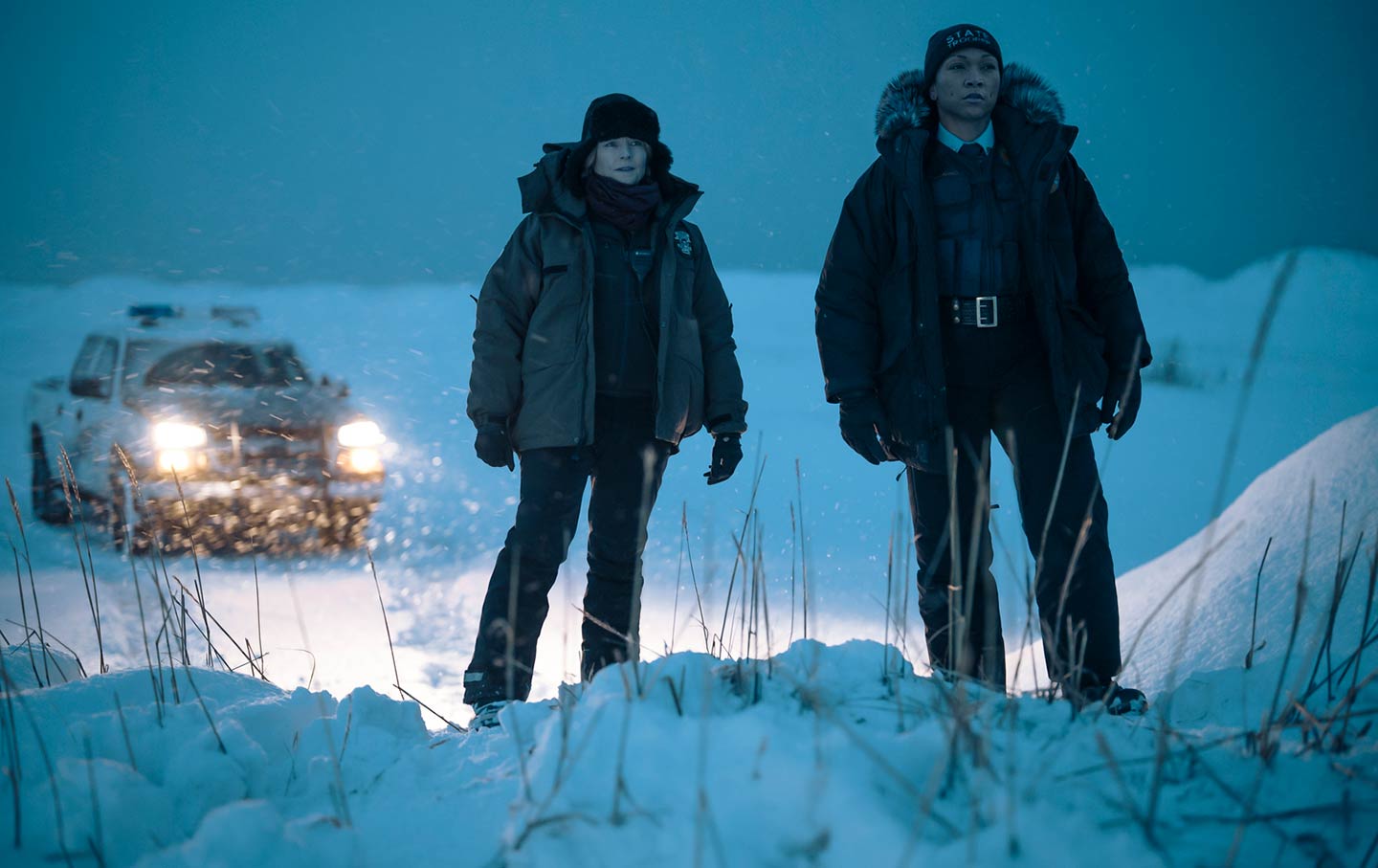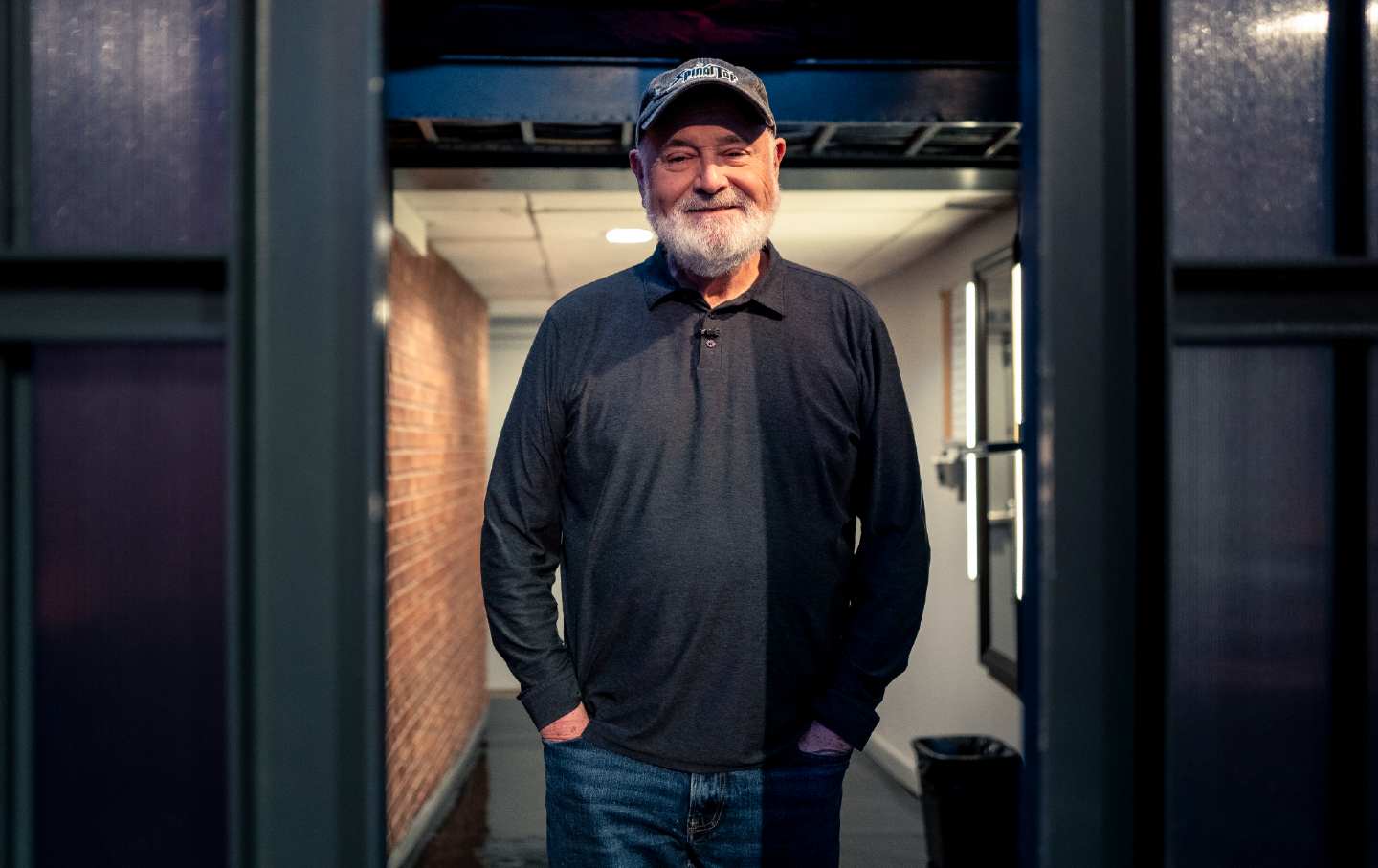The Unanswered Questions of True Detective
The Unanswered Questions of “True Detective”
Like a Raymond Chandler detective story, Night Country ultimately wants to turn its audience’s attention away from the mysteries of the dead toward those of the living.

When the first season of True Detective appeared in 2014, we were living in a different era of television—before auteur series and anthologies were commonplace, when seeing movie stars on the small screen still meant something, when a writer’s or a director’s vision could be so novel as to draw millions to their proverbial water coolers. It wasn’t just a buttoned-up Woody Harrelson and a gaunt and philosophical Matthew McConaughey that lured us in, but the layered timelines, the potentially cosmic intrigue, Nic Pizzolatto’s indulgent verbosity, and Cary Joji Fukunaga’s absorbing camera.
Now, a decade later, with the appearance of True Detective’s fourth season—its first without Pizzolatto at the helm and its first with a subtitle, Night Country—movie stars and auteurist directors are no longer novel. Since True Detective’s debut in 2014, we’ve had Clive Owen and Steven Soderbergh (The Knick), Jude Law and Paolo Sorrentino (The Young Pope), Alicia Vikander and Olivier Assayas (Irma Vep). Spike Lee, Baz Luhrmann, Lana and Lilly Wachowski, Barry Jenkins, Park Chan-wook, and Steve McQueen have all directed television series; Nicole Kidman and Reese Witherspoon have starred in several. High-production values have become a cliché. The fourth season’s first puzzle, then, is how to make itself anew: Can Night Country’s creator, director, and primary writer, Issa López, give us something bracing and different that still feels like True Detective?
From the start, there are clear commonalities between Night Country and the original season of True Detective. Both have high-wattage Hollywood actors and a story anchored by its atmosphere and sense of place. Both are invested in unresolved cosmic conspiracies and the fine line between losing your mind and “mainlining the secret truth of the universe.” Night Country crystallizes this connection in a recurring symbol from the first season, a crooked spiral, expanding on associations from one temporal and geographical space to the other. If time is a flat circle, then so are television shows.
But in other ways, Night Country serves as a negative image of the first season: It begins with missing men rather than a woman dead and displayed. Its protagonists are female detectives instead of male ones. It trades the sprawling swamps and twisted trees of Louisiana for the blank, withholding darkness of the Arctic. Instead of the sticky, suppurating landscape of the first season, we get a petrified tundra on the other end of the continent.
Night Country also has its own unique mysteries. There is the horrifying “corpsicle,” an unexplained disappearance, and an earlier unsolved murder. But López is interested in uncertainty of a different kind: She uses the landscape and darkness to develop an eerie, frigid atmosphere. Beyond the arrant philosophizing of the first season—most memorably McConaughey’s self-serious and unintentionally humorous nihilism—the rabbit holes in Night Country are more profound. Murder is the gravitational force that draws the story forward, but it sucks both the living and the dead into an endless turmoil. Cases go unsolved for years and often seem adjacent to deeper questions about the cosmos that haunt those attempting to close them. The show’s real questions, it turns out, are ones without answers: mysteries about belief, metaphysics, and identity that no detective can truly resolve.
Set in a fictional mining town in Alaska so far north that the sun does not rise for weeks in the winter, True Detective: Night Country introduces us to this deadly, darkened landscape before we meet any of its heroes or villains. Watching as the last sunset fades over the horizon of Ennis, we are trapped in the town’s sunless season, in which the distinction between day and night loses all meaning. Ennis’s remoteness makes it difficult to track where and when things occur. Lab results could take days to arrive, and the mining that sustains the local economy has also undermined the town’s water quality. It is so cold that venturing outdoors is a life-risking proposition.
Although this might sound like an inhospitable place, people do live here: woo-woo white people, environmentalist organizers and agitators, rough men hardened by work in the mines, and the Iñupiat trying to maintain a connection to their land and heritage. Cooped up in this small town, people also create their own life-risking situations: Miners and environmental organizers frequent the same bar, after all. Everyone knows everyone. Moments after a drunk driver rams into a pole in the first episode, a neighbor calls out, “Is that fucking Stacy Chalmers again?”
Even greater dangers lurk outside the town—especially at the Tsalal Arctic Research Station, an outpost even more remote than Ennis. There, a diverse group of scientists have spent years penetrating the permafrost in search of the origins of life, in the hopes of finding a primordial panacea that could hold the key to curing cancer, autoimmune diseases, and genetic disorders. But then, after the last sunset of the year, the scientists disappear suddenly and without a trace. The only thing left behind is a human tongue.
Enter Ennis’s police chief, Liz Danvers, played with a world-weary gravitas by Jodie Foster. This is Foster not as Clarice Starling, the FBI Academy student in The Silence of the Lambs, but as Jack Crawford, Clarice’s wise but flawed mentor, who doesn’t shy away from exploiting his underlings in pursuit of the truth. Danvers is clearly good at her job, and her skills of deduction are on full display from the outset, when she schools her second-in-command, Hank (John Hawkes), as they navigate the crime scene. Like many of TV’s brilliant but difficult sleuths, Danvers is a curmudgeon, a philanderer, and always on the clock. She’s good police but bad company.
Considering the staff she has to rely on, it’s hard to blame her: The rest of the Ennis police force bumble around damaging the crime scene and taking selfies instead of making themselves useful. That is, except for Pete (Finn Bennett), who is Hank’s son but, more importantly, Danvers’s protégé. He serves as her sounding board, her assistant, her student, and through him we see how all of these could be a mixed blessing. Danvers demands too much—of herself and others. The case, for her, is all-consuming, and as they get deeper and deeper into it, Pete follows her lead. He forsakes his wife’s affections, stops tucking their son into bed, and skips Christmas Eve.
The show’s counterweight to Danvers is not Hank but a former acolyte who is no longer in awe of the police chief: Evangeline Navarro, played by the skillful Kali Reis. She used to work with Danvers, but following complications with a messy case she has moved on to the state troopers. Now, despite her removed role, she gets roped into working with Danvers again, though neither relishes the opportunity.
Once the two are drawn together, the show really takes off. The series now has moved solidly into True Detective territory: Like Rust and Marty in season one, Navarro and Danvers are an odd couple, one a believer and the other a skeptic, one committed to justice and the other a cynic. They annoy and know too much about each other, but there’s a grudging respect too. Navarro is no longer swayed by Danvers’s brilliance and charisma, but she is not unlike her in many ways: Standoffish, she embraces her cases wholeheartedly; she’s quick to use men for sex; and her family is a headache rather than a comfort.
Yet what the two really share is something else. As the story of detection unfolds in Night Country, we realize that Danvers and Navarro are searching for something more than just a killer; they are both searching for answers to their own unresolved pasts. Danvers is trying to forget a loss that has closed her off from others, while Navarro is trying to understand and embrace her own Iñupiaq heritage on her mother’s side. When Navarro meets an Iñupiaq person, she’s often asked, “What’s your name?”—as in, “What’s your Iñupiat name, your real name?” And Navarro has no answer. Though the pair might get far asking the wrong questions, they will eventually have to listen for the answers that are calling to them.
After the remains of the Tsalal scientists are discovered, Night Country shifts from a missing-persons story to a murder mystery. One day, a woman living on the town’s outskirts finds the bodies frozen together, gaping in horror, like an ice sculpture modeled from Francisco Goya’s Black Paintings. Their clothes are neatly folded nearby. Navarro spots a crooked spiral on the forehead of one of the victims: It’s the same crooked spiral that Rust sees everywhere as he and Marty try to solve the Dora Lange murder in season one. Something primordial is at work. “It’s old, missy,” the woman who found the scientists’ bodies tells Navarro. “Older than Ennis. It’s older than the ice, probably.”
Soon, both Navarro and Danvers begin to see the connections all around them. They find evidence that a cold case involving a murdered Iñupiat activist is tangled up with the Tsalal deaths: The victim, Annie Kowtok, had a spiral tattoo on her back that not only matches the spiral on the dead scientist’s forehead, but also a tattoo that one of the other Tsalal researchers, Raymond Clark (the only one still missing, and who was apparently involved in a secret relationship with Annie), got in the days immediately after her death. The spiral is a warning, but as the story lines of Night Country continue to unfurl, we realize that it embodies the show’s structure, too: We are caught in a spiral that moves outward from one perspective and, from another, curls ever inward toward a single point.
Popular
“swipe left below to view more authors”Swipe →The spiral is symbolic of something else as well: the unexplainable forces that lurk in the mining town and Alaska’s bitter and dark tundra. Navarro can’t deny the spiritual connections it awakens in her. She comes face to face with a one-eyed polar bear; she hears voices; the frozen ocean calls out to her. Danvers, though, is forceful and close-minded: “You talk to God?” she asks incredulously. “No,” Navarro replies. “I listen.” But others in town share Navarro’s mysticism. “This is Ennis, man,” a driver tells Pete, the young deputy. “You see people who are gone sometimes. It’s a long fuckin’ night. Even the dead get bored.”
Raymond Chandler is one of the key figures in American detective fiction and inevitably an influence on True Detective. He’s there in the show’s pulpy roots and its hard-boiled antiheroes. But there is another element of Chandler that runs throughout the show. As Fredric Jameson once observed of Chandler’s work, at its core is the effort to demystify the story of a murder. Instead of a more classical detective story in which the central murder is “a kind of abstract point which is made to bear meaning and significance by the convergence of all lines upon it,” the hallmark of the Chandlerian narrative is that the murder is ultimately revealed to be a decoy or a diversion from the story’s true aim: bringing us face to face with death, with an “opening onto the not-World, onto its edge and its end, in the void, in non-human space, in death.”
Night Country, at its most potent, begins where Chandler ends. Ennis is a place close to death, already a neighbor to it; it is precarious, otherworldly, stygian. This isn’t just a metaphor for Night Country: How else to describe an Arctic zone of unending night at the edge and end of the world but as a “void” and an almost “non-human space”? The show revels in it and even romanticizes it. When one struggling character loses her life to suicide, the show frames her elegantly walking out onto the ice, seemingly without pain, just crossing over to the unseen territory of death. At other times, the force of this otherworldly landscape and terrain raises more questions than the show can ever answer. Danvers and Navarro visit locations and revisit them. They talk to informants who prove to be more exemplary than insightful. The turns they take in their investigation can feel perfunctory to the show’s central mystery. By the end, we know that Danvers and Navarro will need to go deeper into the ice, into a world even darker and lonelier than Ennis. But when you start at the edge of death, the journey to revelation is both too long and too short. The detectives might solve the case, yet the show’s true questions are about what haunts them and the town. Is it a higher force, a source of evil, or just the facts of life in the Arctic? They ignore that darkness; they fight it and pursue it. But in the end, maybe it’s just about making peace with the mystery.
Disobey authoritarians, support The Nation
Over the past year you’ve read Nation writers like Elie Mystal, Kaveh Akbar, John Nichols, Joan Walsh, Bryce Covert, Dave Zirin, Jeet Heer, Michael T. Klare, Katha Pollitt, Amy Littlefield, Gregg Gonsalves, and Sasha Abramsky take on the Trump family’s corruption, set the record straight about Robert F. Kennedy Jr.’s catastrophic Make America Healthy Again movement, survey the fallout and human cost of the DOGE wrecking ball, anticipate the Supreme Court’s dangerous antidemocratic rulings, and amplify successful tactics of resistance on the streets and in Congress.
We publish these stories because when members of our communities are being abducted, household debt is climbing, and AI data centers are causing water and electricity shortages, we have a duty as journalists to do all we can to inform the public.
In 2026, our aim is to do more than ever before—but we need your support to make that happen.
Through December 31, a generous donor will match all donations up to $75,000. That means that your contribution will be doubled, dollar for dollar. If we hit the full match, we’ll be starting 2026 with $150,000 to invest in the stories that impact real people’s lives—the kinds of stories that billionaire-owned, corporate-backed outlets aren’t covering.
With your support, our team will publish major stories that the president and his allies won’t want you to read. We’ll cover the emerging military-tech industrial complex and matters of war, peace, and surveillance, as well as the affordability crisis, hunger, housing, healthcare, the environment, attacks on reproductive rights, and much more. At the same time, we’ll imagine alternatives to Trumpian rule and uplift efforts to create a better world, here and now.
While your gift has twice the impact, I’m asking you to support The Nation with a donation today. You’ll empower the journalists, editors, and fact-checkers best equipped to hold this authoritarian administration to account.
I hope you won’t miss this moment—donate to The Nation today.
Onward,
Katrina vanden Heuvel
Editor and publisher, The Nation
More from The Nation

Rob Reiner’s Legacy Can't Be Sullied by Trump’s Shameful Attacks Rob Reiner’s Legacy Can't Be Sullied by Trump’s Shameful Attacks
The late actor and director leaves behind a roster of classic films—and a much safer and juster California.

Blood Orange’s Sonic Experiments Blood Orange’s Sonic Experiments
Dev Hynes moves between grief and joy in Essex Honey, his most personal album yet.

Ars Poetica with Backup from The Clark Sisters Ars Poetica with Backup from The Clark Sisters
after “Is My Living in Vain?”, 1980

Helen DeWitt and Ilya Gridneff’s Sweeping Anti-War Novel Helen DeWitt and Ilya Gridneff’s Sweeping Anti-War Novel
Your Name Here dramatizes the tensions and possibilities of political art.



